
The Financial Sector 20-day EMA dropped down through the 50-day EMA (Dark Cross) while below the 200-day EMA, generating an IT Trend Model SELL signal. If we see price continue in the trading range between $33 and $36, we are likely to get some whipsaw on our IT Trend Model. Like all of the sectors, the indicators aren't favorable, in particular the falling PMO and negative RSI. XLF does have the benefit of only slight deterioration of the %Stocks > 20/50/200-day EMAs while other sectors have been decimated. Still, this type of participation isn't anything to hang your hat on.
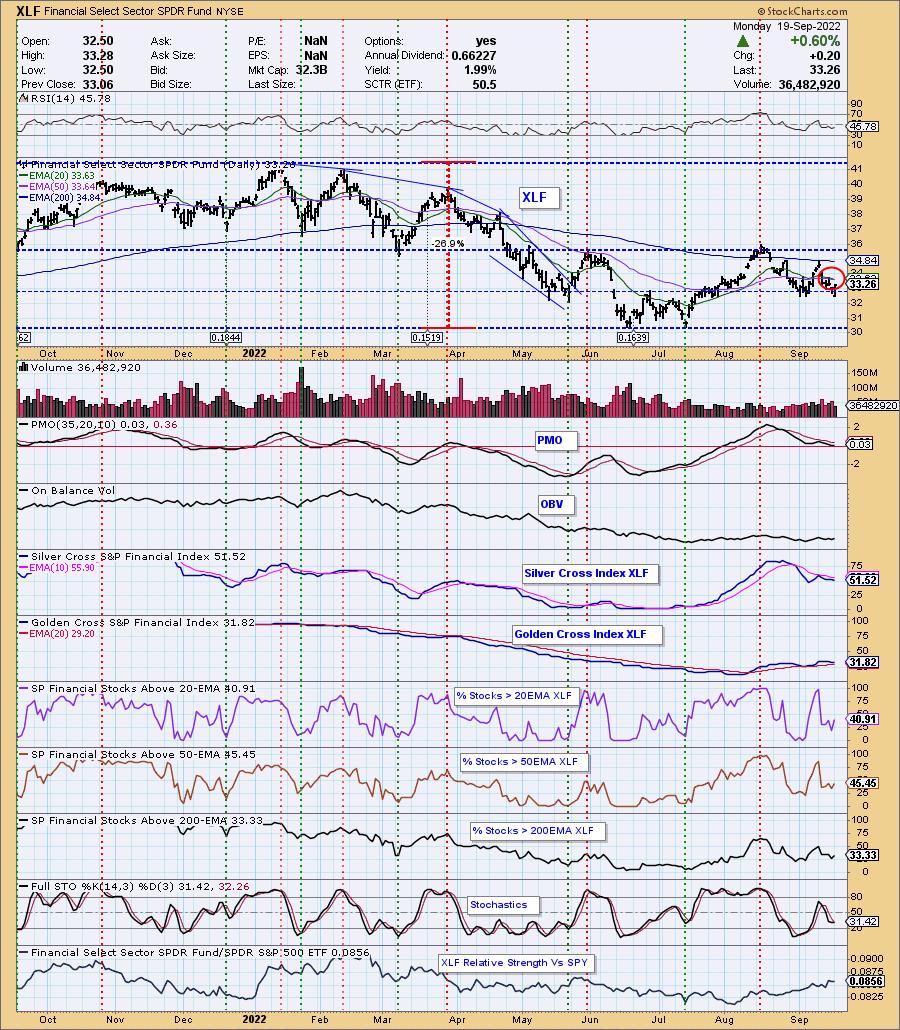
The DecisionPoint Alert Weekly Wrap presents an end-of-week assessment of the trend and condition of the Stock Market, the U.S. Dollar, Gold, Crude Oil, and Bonds. The DecisionPoint Alert daily report (Monday through Thursday) is abbreviated and gives updates on the Weekly Wrap assessments.
Watch the latest episode of DecisionPoint on StockCharts TV's YouTube channel here!
MAJOR MARKET INDEXES
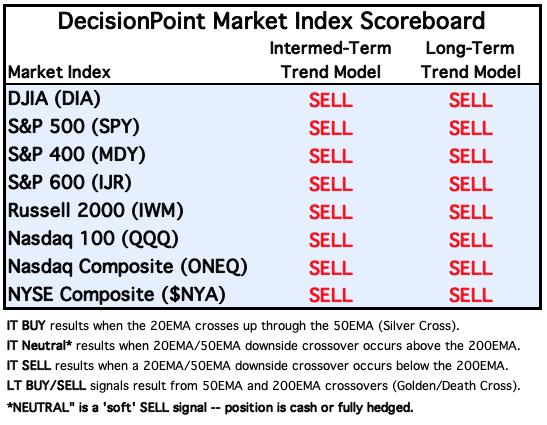
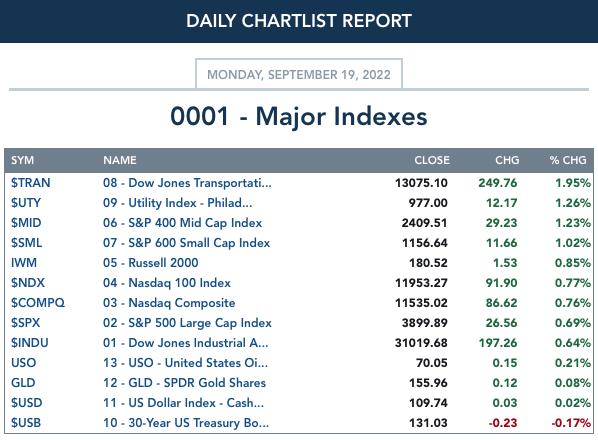
SECTORS
Each S&P 500 Index component stock is assigned to one of 11 major sectors. This is a snapshot of the Intermediate-Term (Silver Cross) and Long-Term (Golden Cross) Trend Model signal status for those sectors.
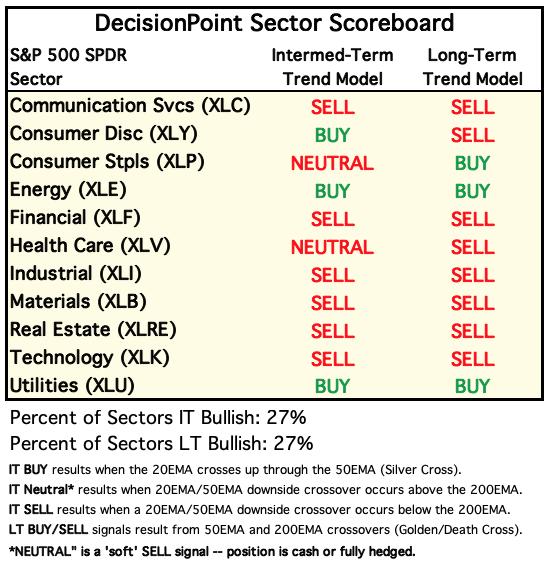
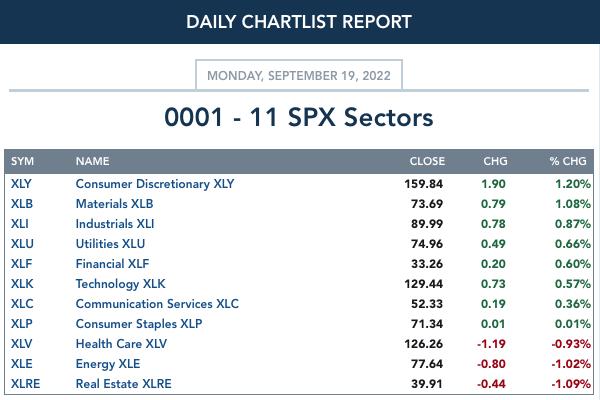
RRG® Charts ($ONE Benchmark)
Daily: The daily RRG doesn't look that bad overall. Most sectors are heading out of the Lagging quadrant. Given the northerly headings, those in Lagging should reach Improving soon. Of course, a heavy decline in the market would likely result in some bearish southwest headings.
The three strongest sectors are XLY, XLV and XLF which are in the Improving quadrant. They have bullish northeast headings, but at this point a strong easterly heading would work to move them into the Leading quadrant.
XLE is working its way toward the Lagging quadrant as it continues to weaken. XLU is a toss up. Given it is sitting on the center of the graph, it is basically neutral.
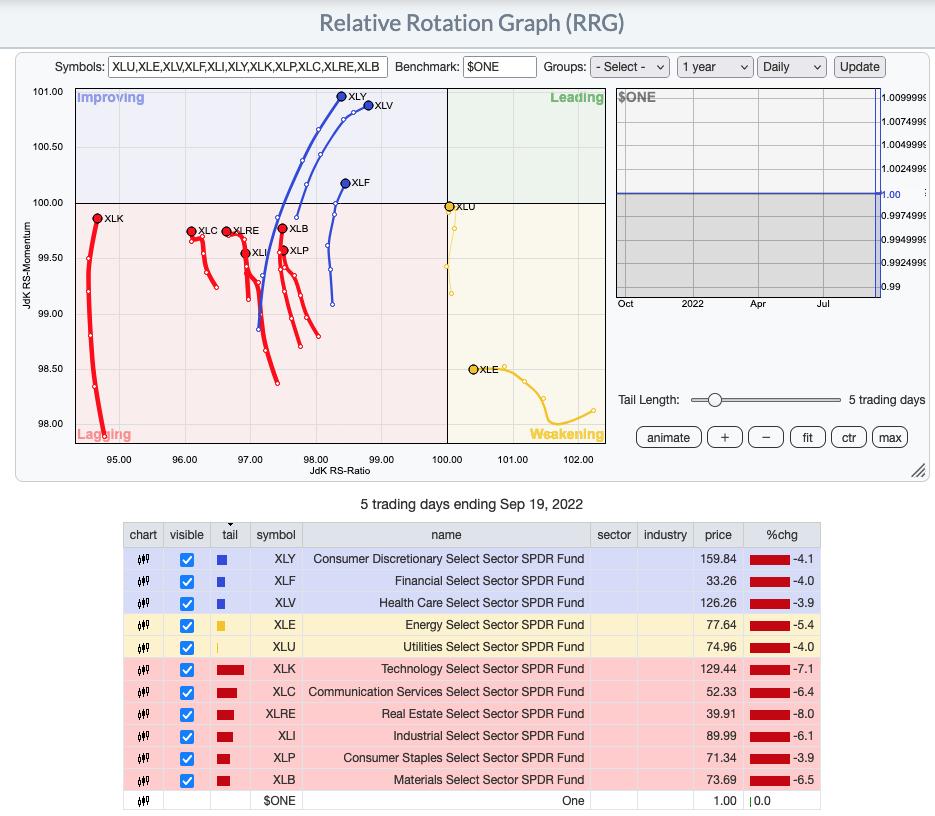
Weekly: The longer-term RRG suggests that the most bearish sectors are XLV and XLP which have bearish southwest headings and are on their way into the Lagging quadrant.
XLC and XLRE are also weak given they are working their way toward the Lagging quadrant.
The strength seems to lie with XLY, XLE, XLU and to some degree XLK and XLI. Obviously, residing in the Leading quadrant is most desirable and XLY, XLE and XLU are already there and their headings haven't deteriorated much. XLK and XLI are very close to entering the Leading quadrant. XLB and XLF have promising headings, but have some distance left to travel before they would reach the Leading quadrant.
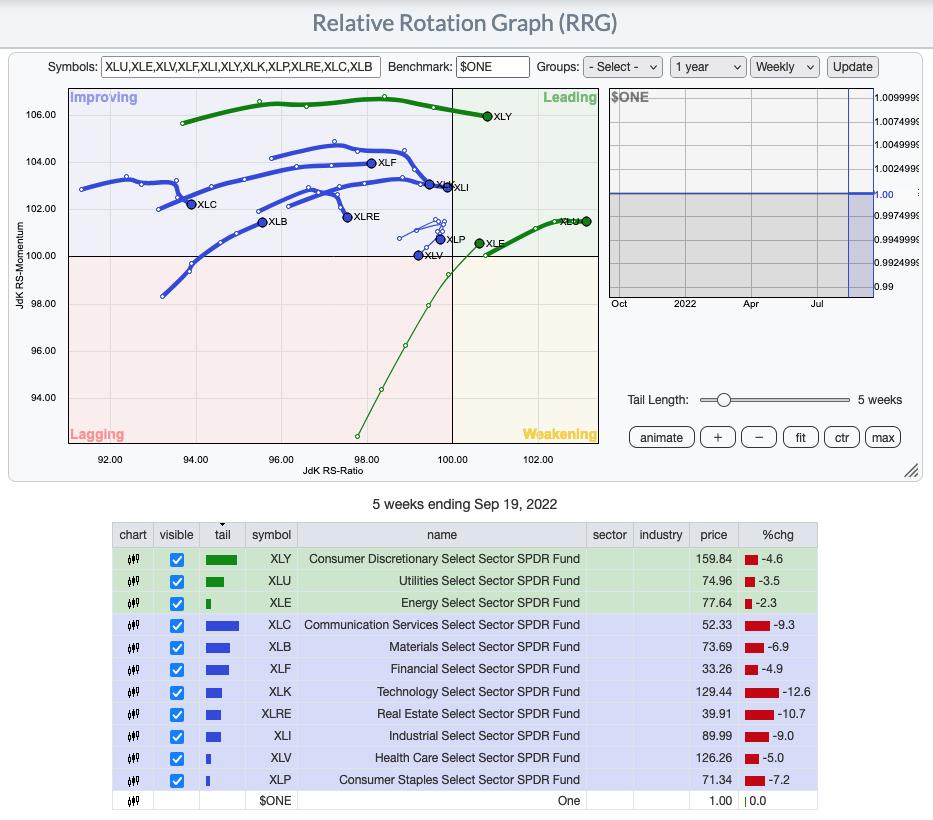
RRG® charts show you the relative strength and momentum for a group of stocks. Stocks with strong relative strength and momentum appear in the green Leading quadrant. As relative momentum fades, they typically move into the yellow Weakening quadrant. If relative strength then fades, they move into the red Lagging quadrant. Finally, when momentum starts to pick up again, they shift into the blue Improving quadrant.
CLICK HERE for an animated version of the RRG chart.
CLICK HERE for Carl's annotated Sector charts.
THE MARKET (S&P 500)
IT Trend Model: BUY as of 8/2/2022
LT Trend Model: SELL as of 5/5/2022
SPY Daily Chart: Good news and bad news for the SPY. Good news would be a bullish falling wedge pattern and a big bullish engulfing candlestick. Additionally price did close above resistance.
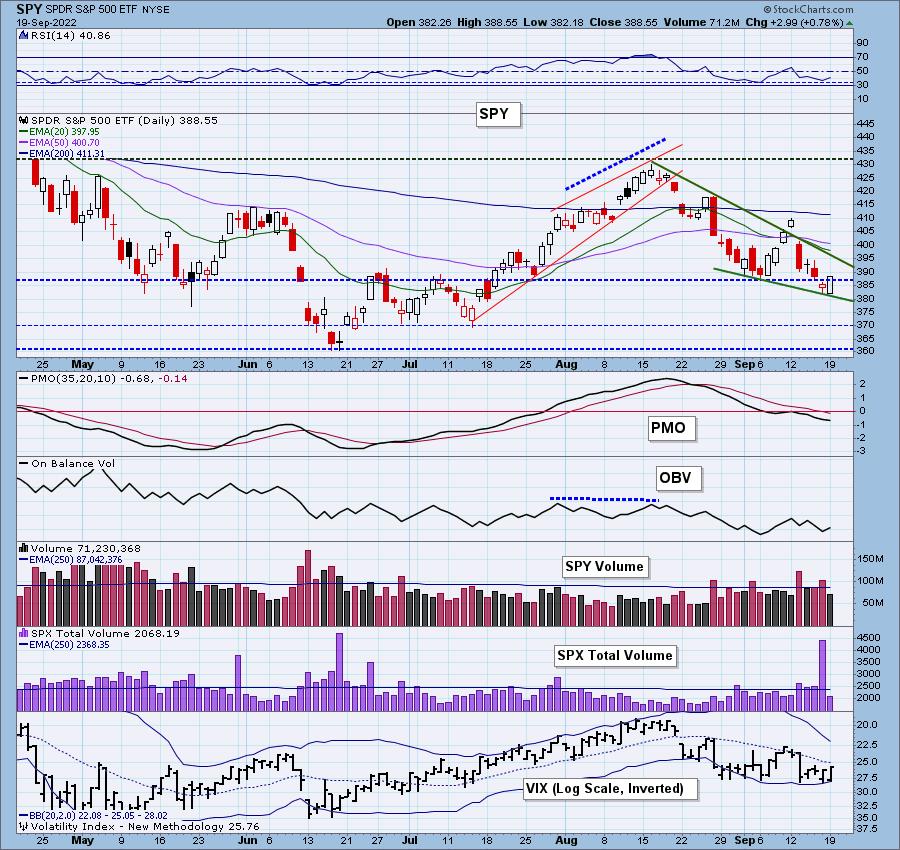
The bad news is that indicators remain bearish. The PMO is especially bearish having topped beneath its signal line and moving below the zero line. The RSI is negative. You'll notice the VIX is oscillating below its moving average on our inverted scale. This implies internal weakness.
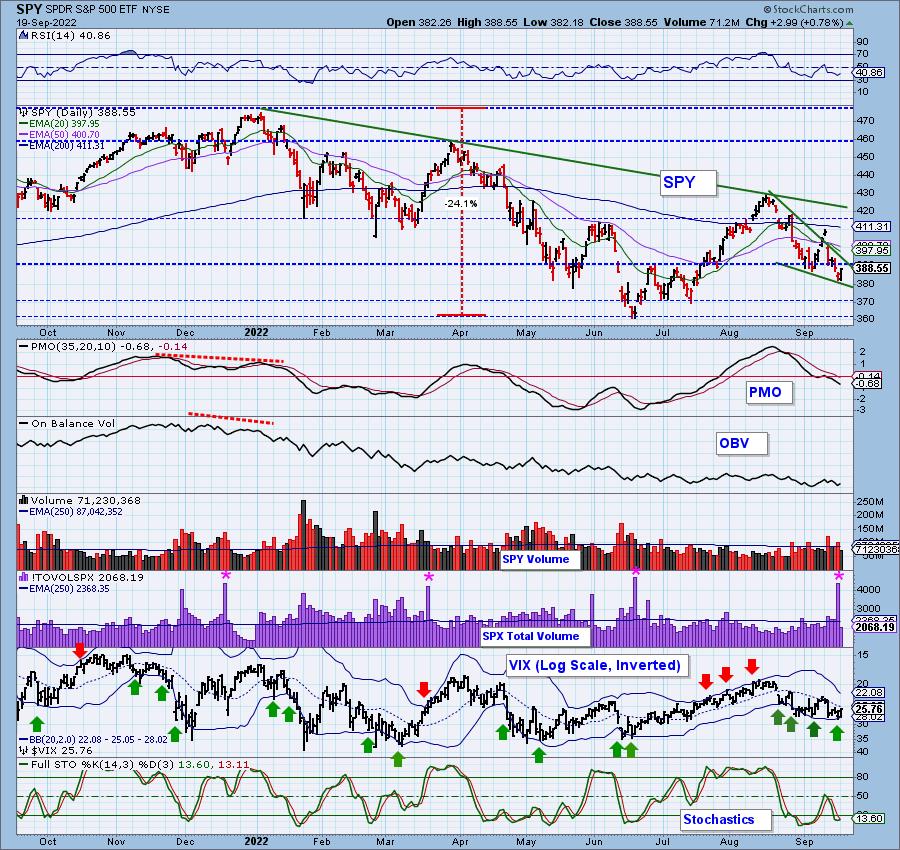
Here is the latest recording:
S&P 500 New 52-Week Highs/Lows: Unfortunately, Friday's expansion of New Lows edged out what could have been a positive divergence. The 10-DMA of the High-Low Differential has topped below the zero line.
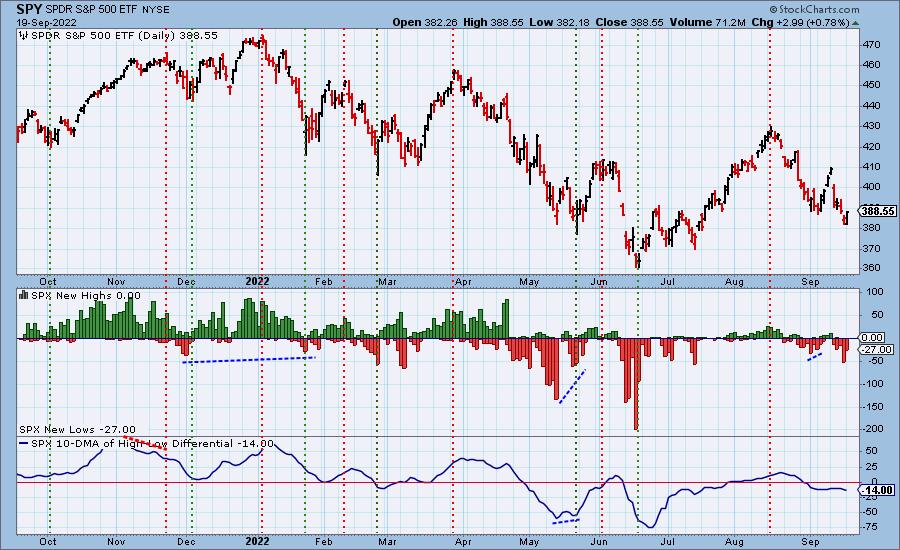
Climax* Analysis: There were some marginal, and not unanimous, climax indications today; nevertheless, we will declare an upside initiation climax.
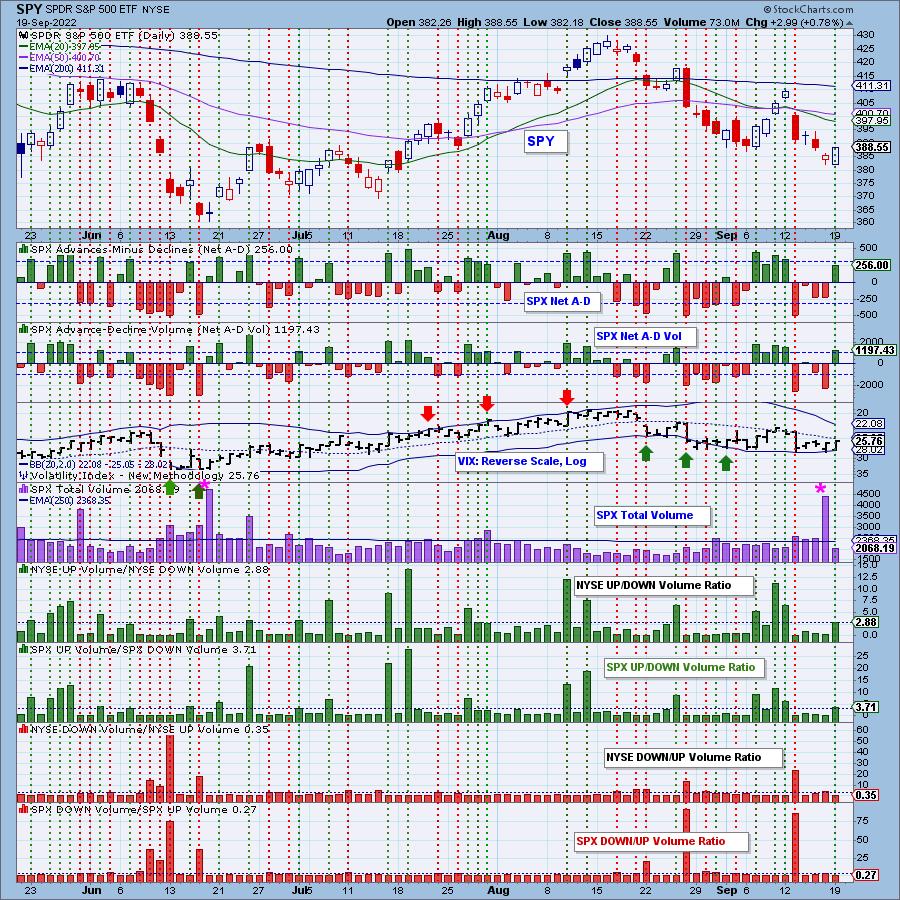
*A climax is a one-day event when market action generates very high readings in, primarily, breadth and volume indicators. We also include the VIX, watching for it to penetrate outside the Bollinger Band envelope. The vertical dotted lines mark climax days -- red for downside climaxes, and green for upside. Climaxes are at their core exhaustion events; however, at price pivots they may be initiating a change of trend.
Short-Term Market Indicators: The short-term market trend is DOWN and the condition is NEUTRAL.
Despite today's rally, the STOs continued to march lower. %Stocks indicators are saw very little improvement. They are somewhat oversold, but not to the degree we saw at the June bottom.
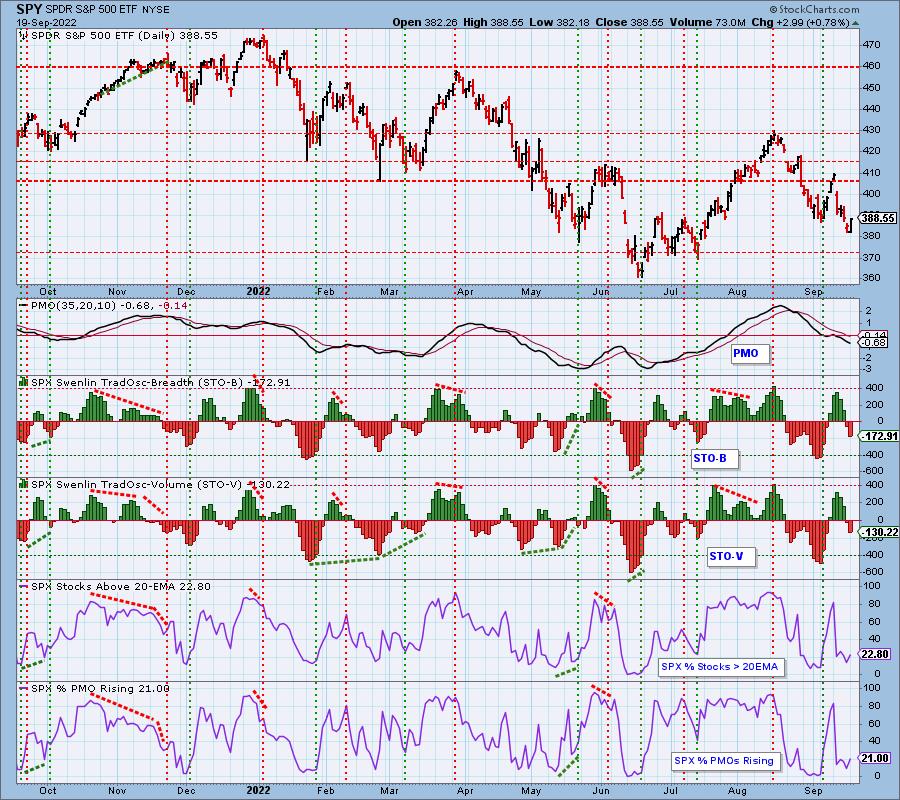
Intermediate-Term Market Indicators: The intermediate-term market trend is DOWN and the condition is NEUTRAL.
The ITVM bottomed today, setting a positive divergence, but the ITBM continued downward ever so slightly.
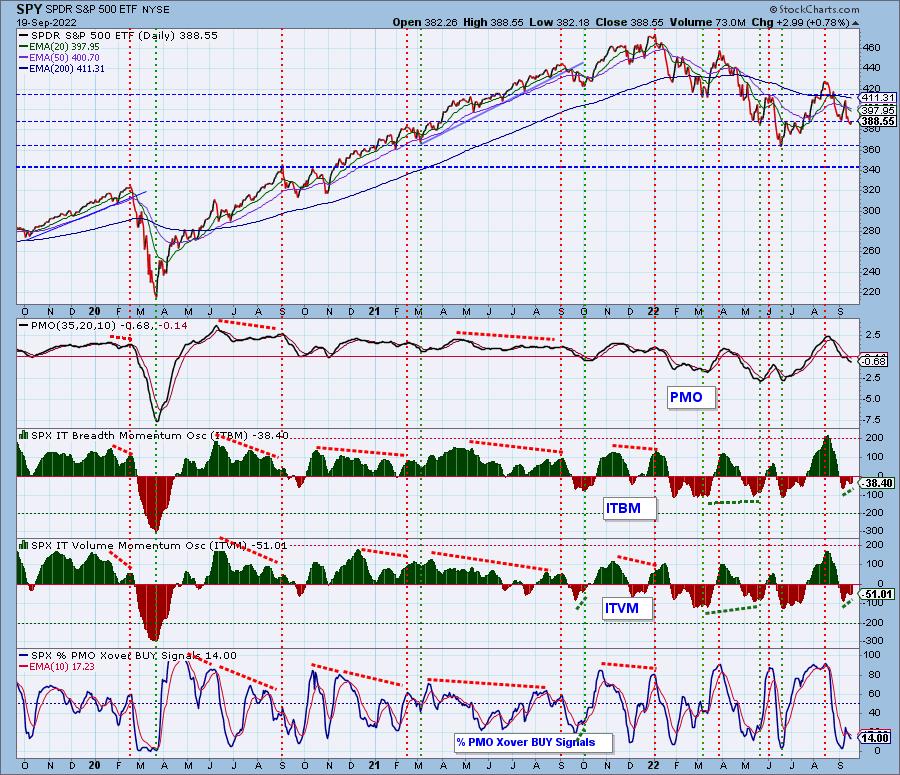
PARTICIPATION and BIAS Assessment: The following chart objectively shows the depth and trend of participation in two time frames.
- Intermediate-Term - the Silver Cross Index (SCI) shows the percentage of SPX stocks on IT Trend Model BUY signals (20-EMA > 50-EMA). The opposite of the Silver Cross is a "Dark Cross" -- those stocks are, at the very least, in a correction.
- Long-Term - the Golden Cross Index (GCI) shows the percentage of SPX stocks on LT Trend Model BUY signals (50-EMA > 200-EMA). The opposite of a Golden Cross is the "Death Cross" -- those stocks are in a bear market.
The bias remains bearish in all three timeframes.
Short term: We have a very low number of stocks above their 20/50-day EMAs. While the readings did tick up today, it wasn't enough to change the short-term bias.
Intermediate term: The SCI is at a low 43.2% which in and of itself is bearish, but we also see lower percentage of stocks above their 20/50-day EMAs. This implies that the SCI won't be able to move higher. A silver cross can only be generated if the 20-day EMA moves above the 50-day EMA. EMAs will move in the direction of price so price must be above both the 20/50-day EMAs in order to create a new silver cross.
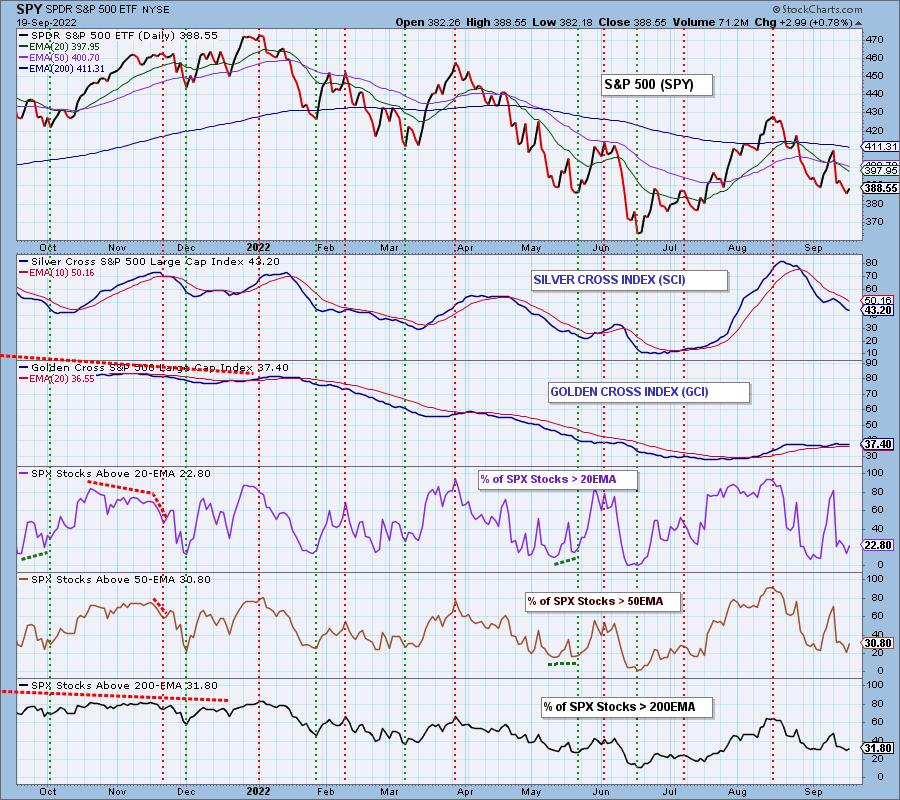
CONCLUSION: Primary indicators (PMO, RSI and Stochastics) are still very negative. However, the SPY has formed a bullish falling wedge, the ITVM is in a positive divergence to price, and we have an upside initiation climax. We're not sure what the Fed might deal out on Wednesday, but the technicals are favorable if the Fed leaves any room for optimism.
Key Earnings Tomorrow: Aurora Cannabis (ACB) and StitchFix (SFIX)
Click HERE for a complete Earnings list from Zacks.com.
Have you subscribed the DecisionPoint Diamonds yet? DP does the work for you by providing handpicked stocks/ETFs from exclusive DP scans! Add it with a discount! Contact support@decisionpoint.com for more information!
BITCOIN
Bitcoin finished higher today and formed a long "tail" on the OHLC bar. That would be a bullish hammer. Coming off support, we could see a rally instead of a breakdown. The indicators leave us less optimistic given the negative RSI, PMO nearing a crossover SELL signal below the zero line and Stochastics angling downward.
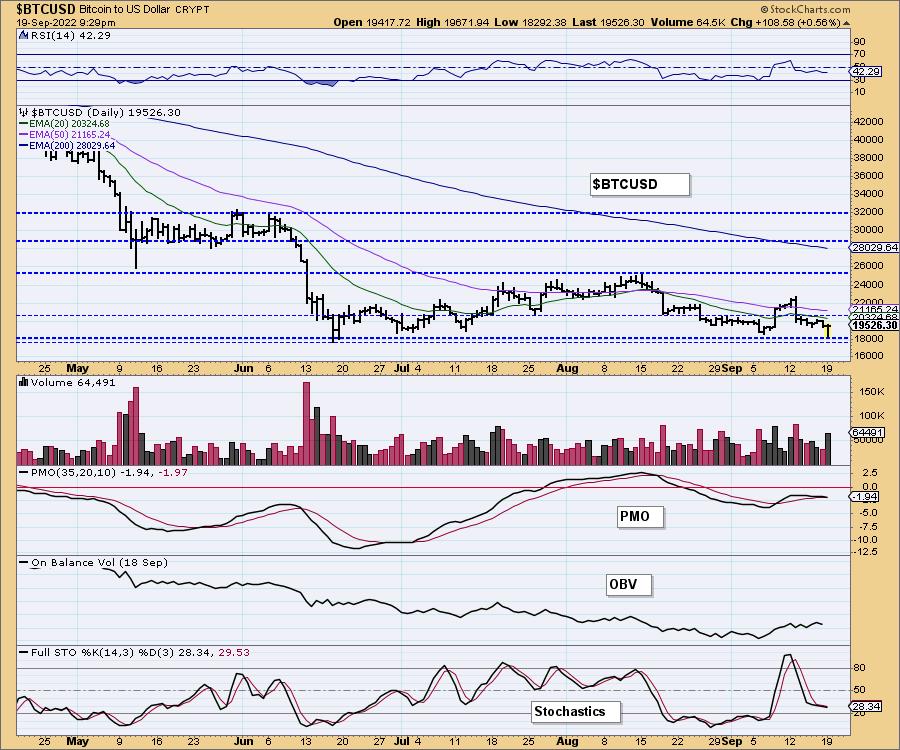
INTEREST RATES
Rates are breaking out to new multi-year highs. Given the FOMC's steps to curb inflation with raising the Fed Funds Rate, the rest seem to be following suit. We expect a rising rate environment to continue.
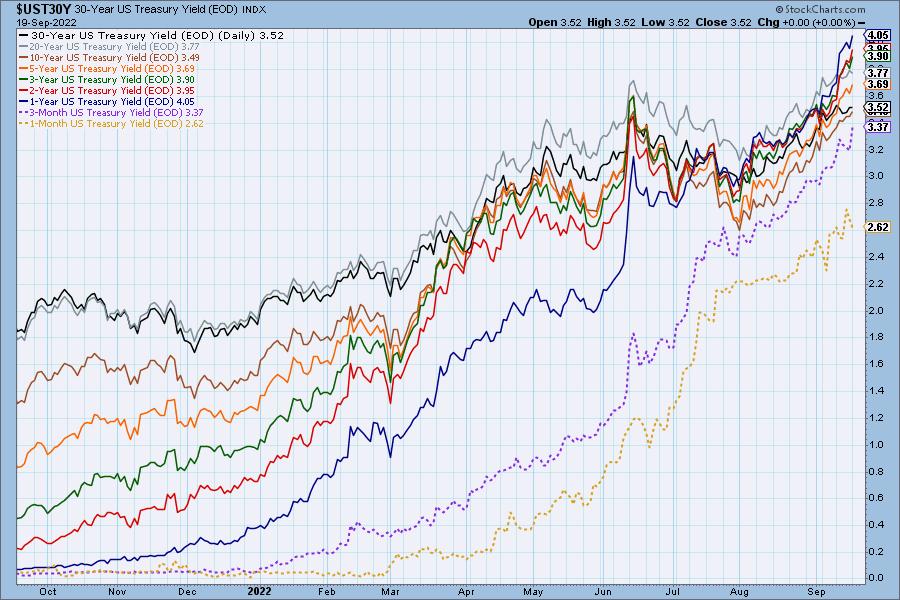
The Yield Curve Chart from StockCharts.com shows us the inversions taking place. The red line should move higher from left to right. Inversions are occurring where it moves downward.
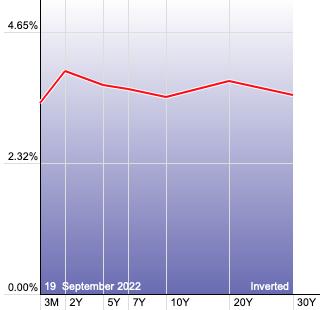
10-YEAR T-BOND YIELD
The $TNX chart does give us some hope that rates will finally start coming down. We have a bearish rising wedge. Of course, today it broke to new multi-year highs and the indicators are very bullish with the PMO rising and not overbought and Stochastics oscillating above 80. The RSI just hit overbought territory above 70, but it can stay that way for weeks (see April).
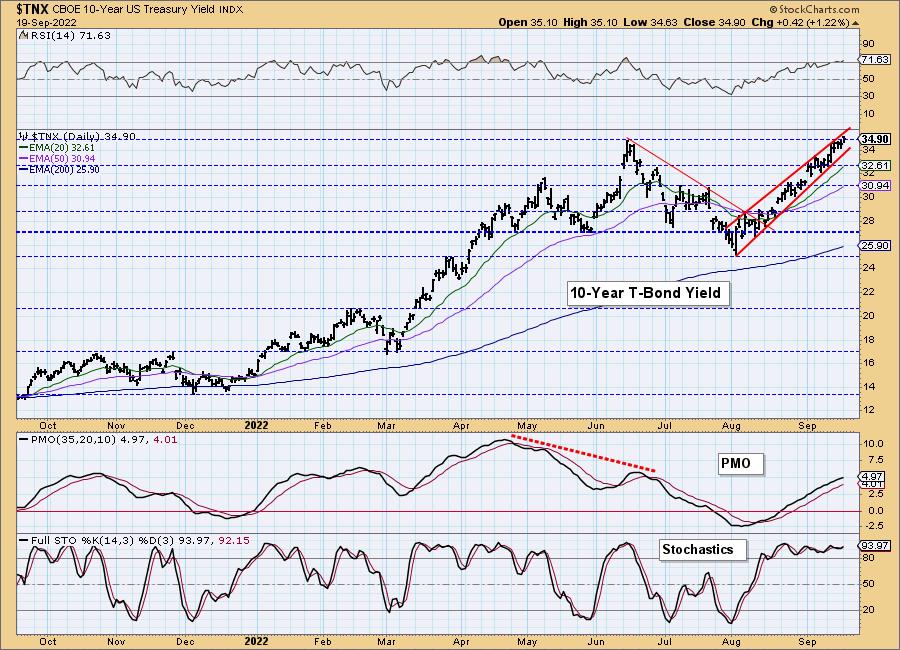
DOLLAR (UUP)
IT Trend Model: BUY as of 6/22/2021
LT Trend Model: BUY as of 8/19/2021
UUP Daily Chart: We're starting to see signs that the Dollar may be ready to test the bottom of the bearish rising wedge. The PMO triggered a crossover SELL signal and Stochastics topped before reaching above 80. The RSI is fine which is indicative of its recent trading range.
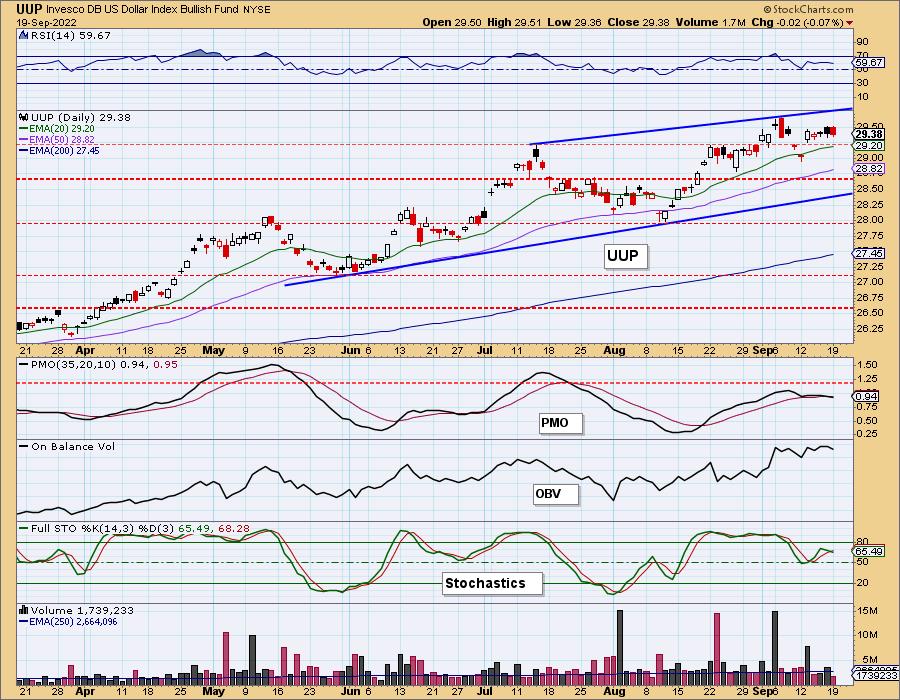
We expect support to be tested (and likely lost) at the July top very soon.
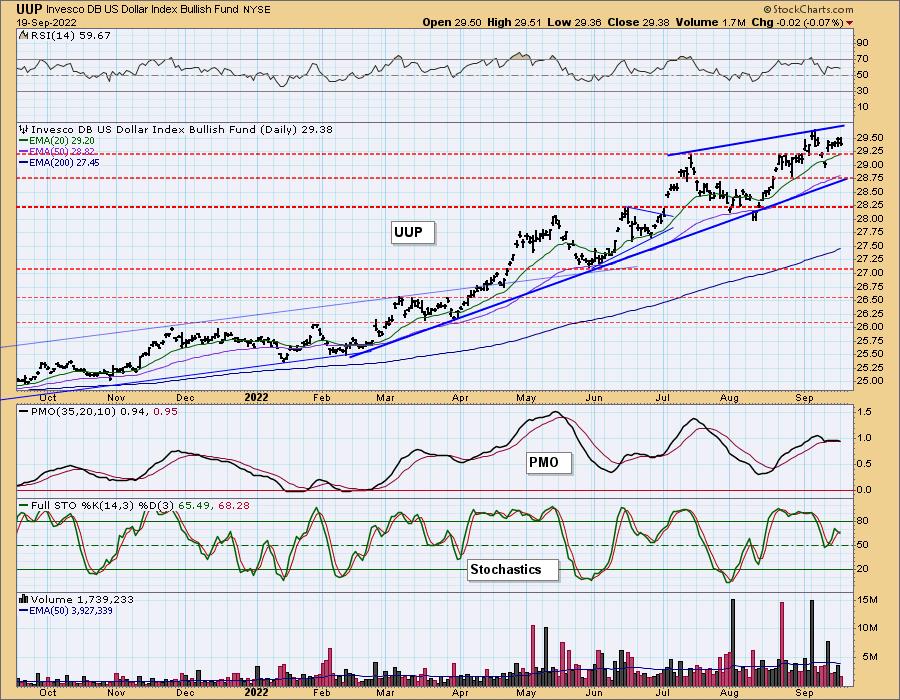
GOLD
IT Trend Model: NEUTRAL as of 5/3/2022
LT Trend Model: SELL as of 6/30/2022
GLD Daily Chart: With the Dollar looking weak, we aren't surprised that GLD pulled off two days of rally. They were signficant enough to change the course of the bearish indicators, but it is encouraging nonetheless. $GVZ is still puncturing the lower Bollinger Band on our inverted scale; this suggests a continuation of this rally.
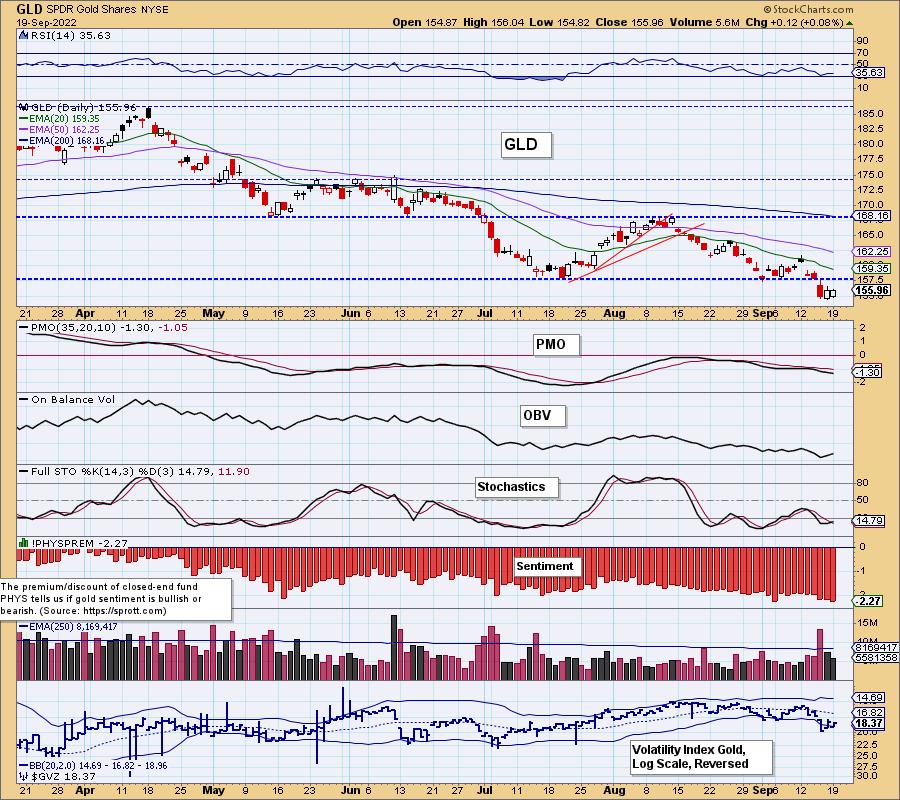
GOLD Daily Chart: Discounts are at the highest level we've seen since December of 2020. Investors are incredibly bearish on Gold. We would expect to see a rally begin here simply based on extreme bearish sentiment.
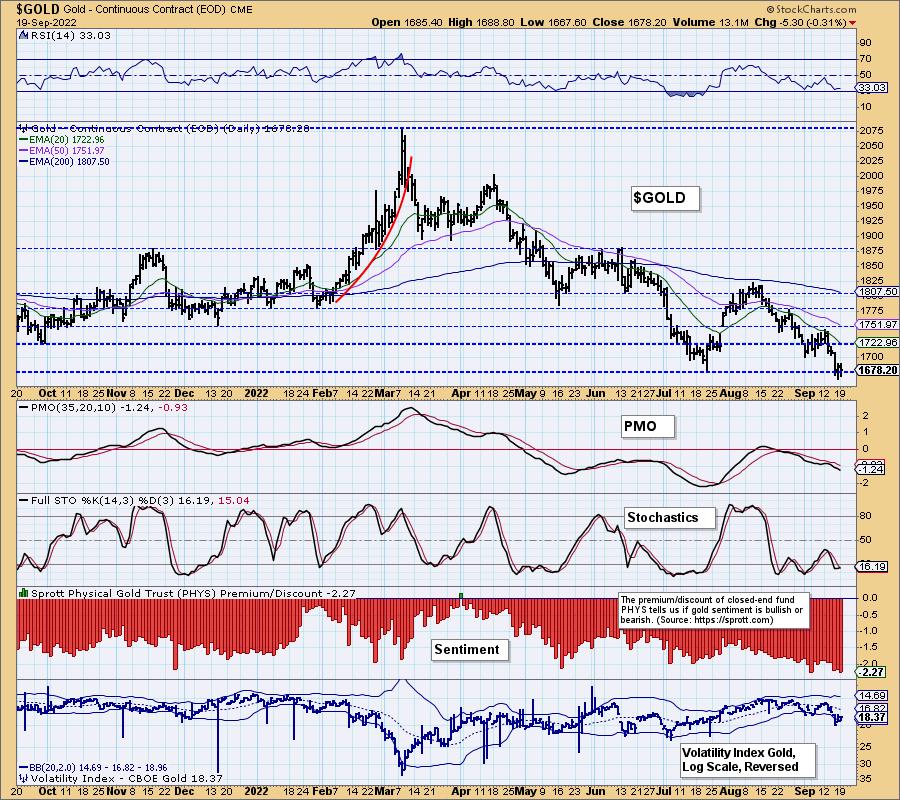
GOLD MINERS Golden and Silver Cross Indexes: GDX bounced off support today and is in the process of forming a bullish double-bottom. The RSI is negative, but it is seeing improvement. The PMO is on a BUY signal (barely). Stochastics have turned back up. It appears that Gold Miners are on track to continue higher as participation of stocks > 20/50-day EMAs are improving quickly again. With the Dollar weakening and Gold on the cusp of a rally, we like GDX's chances of recovery.
(Full disclosure: Erin owns GDX.)
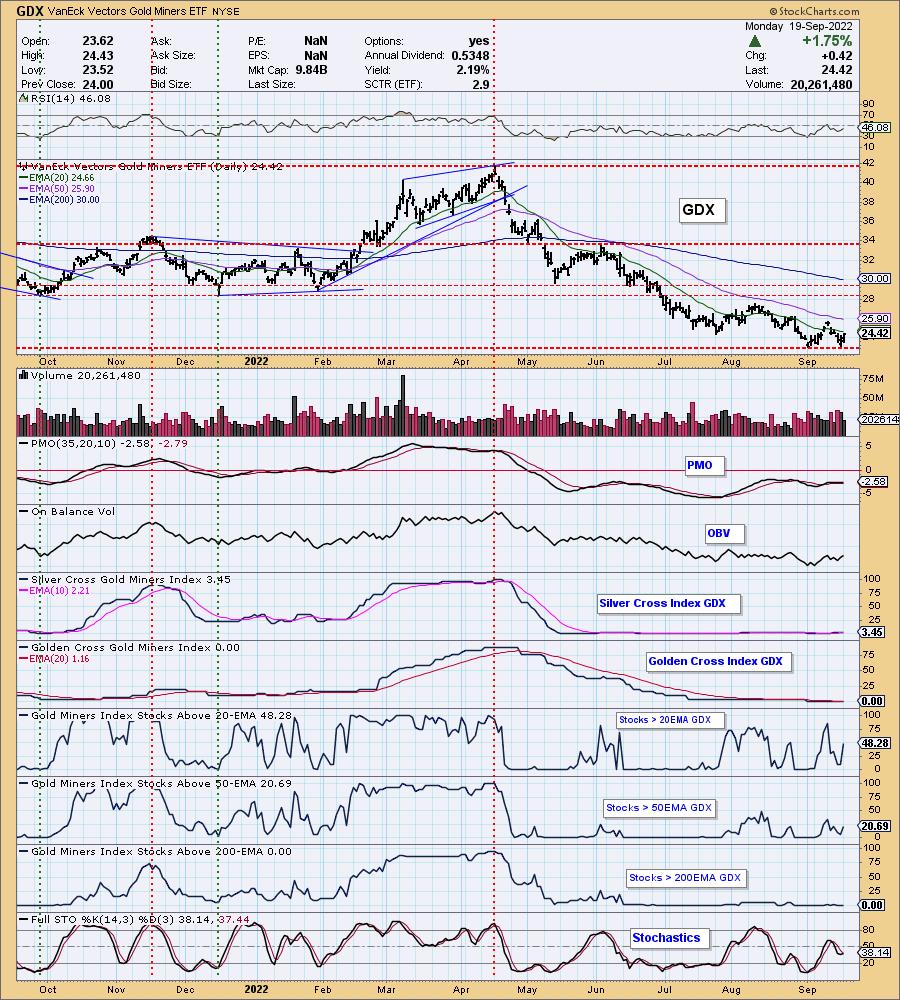
CRUDE OIL (USO)
IT Trend Model: NEUTRAL as of 7/8/2022
LT Trend Model: BUY as of 3/9/2021
USO Daily Chart: After touching down on support at $67.50, USO rallied to finish the day up slightly. The RSI, PMO and Stochastics are neutral to bearish, but the OVX shows oscillation above its moving average. That implies internal strength. If Crude Oil is going to rally, this is a logical place for it to do so.
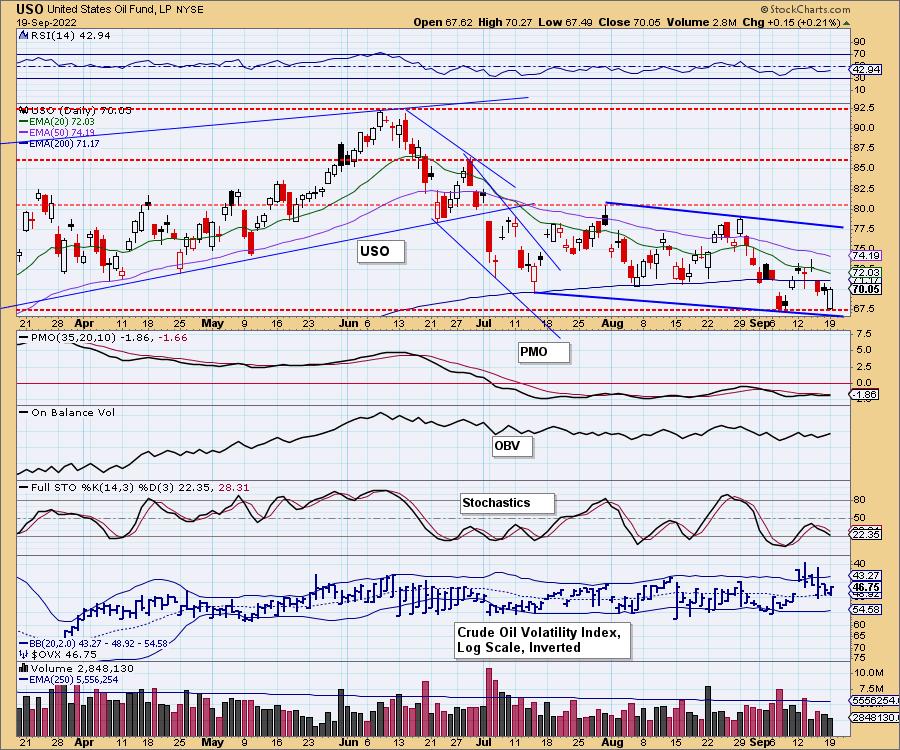
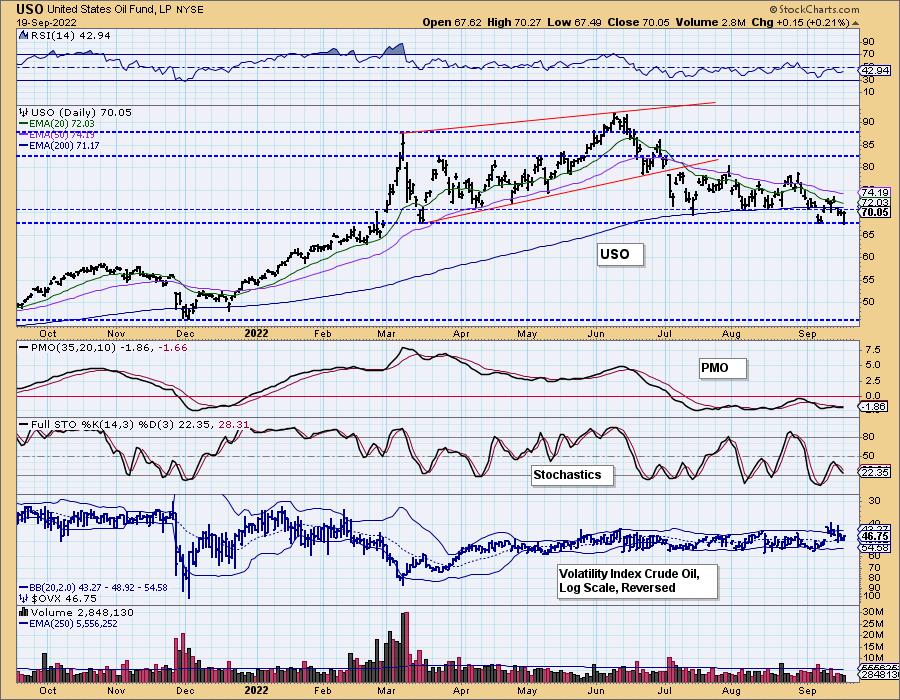
BONDS (TLT)
IT Trend Model: SELLas of 8/19/2022
LT Trend Model: SELL as of 1/19/2022
TLT Daily Chart: TLT may be holding support right now, but doubt it will last given the near vertical rally in yields. The 20-year yield pulled back slightly which prevented the inevitable breakdown we are looking for.
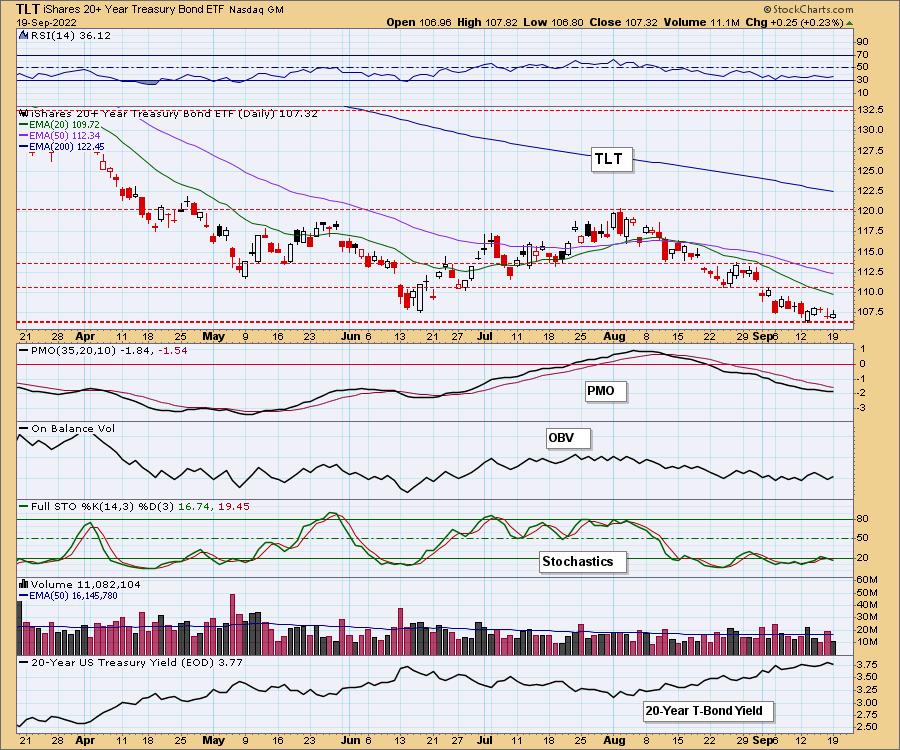
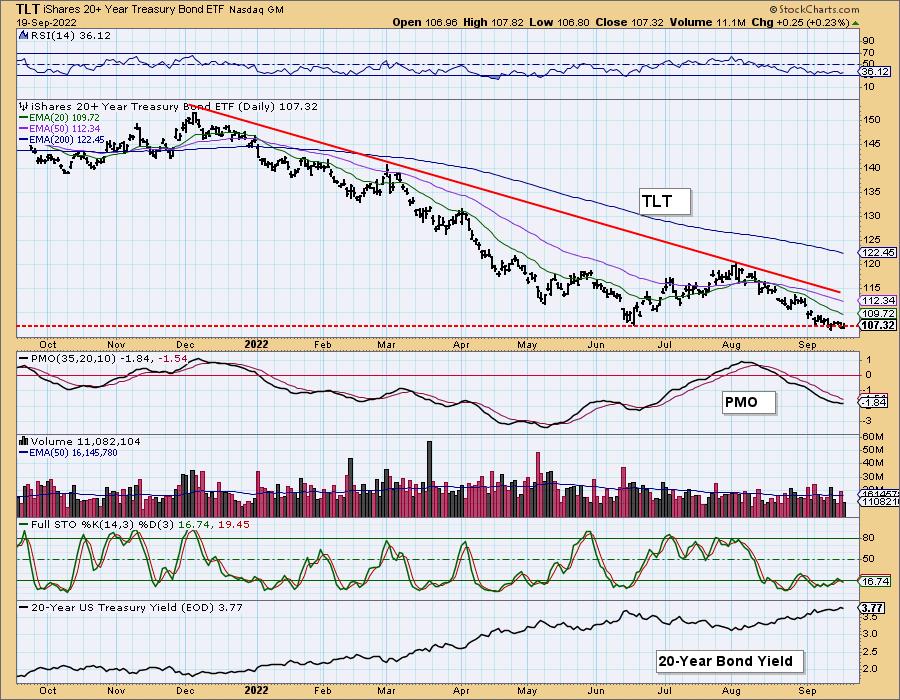
Good Luck & Good Trading!
Erin Swenlin and Carl Swenlin
Technical Analysis is a windsock, not a crystal ball. --Carl Swenlin
(c) Copyright 2022 DecisionPoint.com
Disclaimer: This blog is for educational purposes only and should not be construed as financial advice. The ideas and strategies should never be used without first assessing your own personal and financial situation, or without consulting a financial professional. Any opinions expressed herein are solely those of the author, and do not in any way represent the views or opinions of any other person or entity.
NOTE: The signal status reported herein is based upon mechanical trading model signals, specifically, the DecisionPoint Trend Model. They define the implied bias of the price index based upon moving average relationships, but they do not necessarily call for a specific action. They are information flags that should prompt chart review. Further, they do not call for continuous buying or selling during the life of the signal. For example, a BUY signal will probably (but not necessarily) return the best results if action is taken soon after the signal is generated. Additional opportunities for buying may be found as price zigzags higher, but the trader must look for optimum entry points. Conversely, exit points to preserve gains (or minimize losses) may be evident before the model mechanically closes the signal.
Helpful DecisionPoint Links:
DecisionPoint Alert Chart List
DecisionPoint Golden Cross/Silver Cross Index Chart List
DecisionPoint Sector Chart List
Price Momentum Oscillator (PMO)
Swenlin Trading Oscillators (STO-B and STO-V)
DecisionPoint is not a registered investment advisor. Investment and trading decisions are solely your responsibility. DecisionPoint newsletters, blogs or website materials should NOT be interpreted as a recommendation or solicitation to buy or sell any security or to take any specific action.
